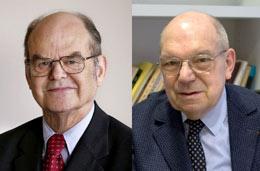 Masters of symmetry: John Griggs Thompson and Jacque Tits.University of Florida and Jean-François Dars/CNRS Images
Masters of symmetry: John Griggs Thompson and Jacque Tits.University of Florida and Jean-François Dars/CNRS ImagesThe Abel Prize, generally considered the ‘Nobel’ of mathematics, has been won this year by two mathematicians whose work has helped to classify the building blocks of symmetry.
John Griggs Thompson of the University of Florida, Gainsville, and Jacques Tits of the Collège de France in Paris, France, have been given the prize, worth 6 million Norwegian kroner (US$1.2 million), for their work on group theory, which describes how the symmetry properties of objects fall into distinct classes or groups.
Group theory is one of the most practically useful branches of pure mathematics, being used in scientific fields ranging from fundamental theories of particle physics to the spectroscopic analysis of molecules.
The symmetries of objects can be described using fundamental ‘symmetry operations’: manipulations that leave the object looking unchanged. This is true of squares and cubes, for example, if they are rotated by a quarter of a full turn, or if they are reflected in various mirror planes that cut the shapes in half.
The full set of such symmetry operations for an object constitutes a 'group'. There is only a limited number of such groups, and they therefore supply a way of putting all shapes (or algebraic equations) into a small number of basic symmetry classes — a kind of 'Periodic Table' of symmetry.
Prime symmetries
Thompson showed that certain symmetry operations can be broken down into more basic, indivisible operations, rather like the way molecules can be decomposed into their elemental atoms. These elemental operations are related to prime numbers. For example, a symmetry rotation of a 15-sided polygon is equivalent to the rotations of a 5-sided polygon and an equilateral triangle, both inscribed inside the original polygon.
“Tits' work is about trying reduce wild to tame behaviour.”
Graham Niblo
In 1963 Thompson and Walter Feit (who died in 2004) proved that the breaking down of symmetries into those of prime-number-sided shapes is always possible for objects with an odd number of symmetries (such as a 15-sided polygon) but not possible for even-numbered ones (such as a 16-sided polygon). Their Odd Order Theorem proof filled 255 journal pages and occupied an entire volume of the Pacific Journal of Mathematics — several other journals rejected the paper because it was too long.
This work showed how to tell whether or not a group was reducible to more fundamental groups, and it led to the recognition that so-called finite groups, which have a finite number of symmetry elements, can be classed into families, leading to the periodic table of such groups. These are enumerated in a dense book called the Atlas of Finite Groups .
Housing the infinite
“The Monster can only be fully seen in 196,883 dimensions.”
Tits has studied the symmetry properties of so-called linear groups, in which the symmetry operations can be infinite in number. There are, for example, an infinite number of rotations of a circle that will leave it looking unchanged.
Although a circle seems a simple shape, the infinite symmetries of such shapes are hard to get a hold on. "Tits' work is about trying to tame the infinite space of these objects, to reduce wild to tame behaviour," says Graham Niblo, a group theorist at the University of Southampton in the UK. Tits' work showed how these groups can be described and analysed in geometric terms, making their properties easier to visualize. He coined the term 'buildings' to describe the geometric structures that arise as a result, and showed that they can be further broken down into so-called 'apartments' and 'chambers'.
Together the work of Thompson and Tits has led to a better understanding of a strange class of symmetrical objects called sporadic groups, which don’t fit into the periodic table of symmetries. "They seem to come from nowhere," says Niblo. The most bizarre of these, and the largest, is an object called the Monster, which can only be fully seen in 196,883 dimensions and has 8 x 1053 symmetry elements. Thompson devised a formula for predicting how many symmetry operations a sporadic group may have, and Tits has studied some of them: one (the Tits group) is named after him.
The Abel Prize, established in 2002, is administered by the Norwegian Academy of Science and Letters in Oslo. It is named after the Norwegian mathematician Niels Henrik Abel, who himself made profound contributions to the foundations of group theory during his short life. Born in 1802, he died aged just 26. Plans for an Abel memorial prize were mooted on the first centenary of his birth, but came to nothing. They were revived on the second centenary, and the first Abel prize was awarded in 2003.



No comments:
Post a Comment